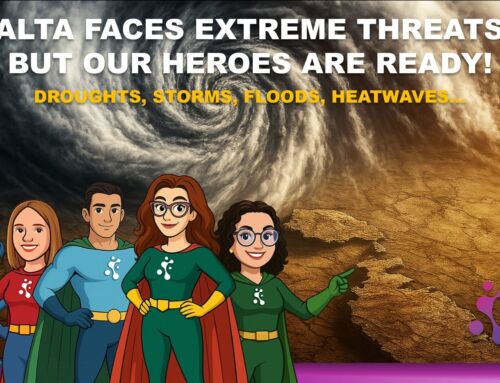Malta’s climate is marked by extremes of heat and humidity, making life on the island particularly vulnerable to climate change. In recent years, the country has seen an increase in the frequency and intensity of heatwaves and droughts, along with fluctuating patterns of rainfall and humidity. Given these challenges, the concept of a utopian climate pattern for Malta becomes highly intriguing. What would a perfect climate for the island look like? How can the various global climate systems that affect the region—such as the El Niño-Southern Oscillation (ENSO) and the North Atlantic Oscillation (NAO)—be optimally aligned to provide the most livable conditions for Malta?
In this editorial, we delve into the ideal configurations of global climate phenomena that would offer Malta a balanced, sustainable climate. This analysis incorporates heat impacts, extreme relative humidity, and the ways in which different climate patterns could mitigate or exacerbate these issues.
Elements of a Utopian Climate Pattern for Malta:
Neutral El Niño-Southern Oscillation (ENSO) Phase
ENSO is one of the most significant climate drivers worldwide, with its two primary phases, El Niño and La Niña, creating major shifts in weather patterns. During El Niño, the Mediterranean often experiences hotter, drier conditions, while La Niña can bring cooler and wetter weather. A neutral ENSO phase would be ideal for Malta, helping to avoid the intense summer heatwaves and dry winters associated with El Niño, as well as the excessively cool conditions linked to La Niña. In a neutral phase, Malta would benefit from consistent temperatures throughout the year, avoiding extreme seasonal fluctuations.
Positive North Atlantic Oscillation (NAO) Phase
The NAO is a key driver of winter weather in the Mediterranean. During its positive phase, Malta experiences milder winters with adequate rainfall, helping to replenish vital freshwater resources without causing excessive flooding. A moderate positive NAO phase would also prevent cold winter snaps, allowing for a pleasant climate year-round. By balancing warm air masses with just the right amount of rainfall, Malta could also avoid the intense summer heatwaves that result from stagnant air masses during a negative NAO phase.
Cool Atlantic Multidecadal Oscillation Phase (AMO)
The AMO operates on much longer timescales—decades rather than years—and its warm and cool phases influence long-term climate trends in Europe and the Mediterranean.
For Malta, a cool AMO phase would be beneficial, as it would counteract the warming trends that contribute to heatwaves and droughts. Cooler sea surface temperatures in the North Atlantic would help moderate summer heat and reduce the likelihood of extreme heat events, while also maintaining steady rainfall to support agriculture and replenish water supplies.
Balanced Mediterranean Oscillation (MO) Phase
The Mediterranean Oscillation (MO), a pressure system specific to the Mediterranean region, plays a critical role in regulating weather patterns across the basin. A balanced MO phase would ensure that Malta avoids the high-pressure systems that trap hot, dry air over the island in the summer. This balance would bring regular rainfall while preventing either severe droughts or flooding, maintaining a stable water supply for the island.
Positive Arctic Oscillation (AO) Phase
The Arctic Oscillation (AO) governs the position of the jet stream, influencing winter conditions across Europe. A positive AO phase would keep cold air masses trapped in the Arctic, ensuring that Malta’s winters remain mild and relatively wet. This would reduce the risk of cold snaps and winter storms, allowing for a comfortable winter climate.
Neutral or Negative Indian Ocean Dipole (IOD) Phase
Though less directly influential on Malta than some other climate patterns, the Indian Ocean Dipole (IOD) does affect global atmospheric circulation. A neutral or negative IOD phase would prevent the extreme hot, dry summers associated with positive IOD phases, helping to maintain more moderate temperatures and adequate rainfall in Malta during the summer.
Saharan Heatwaves – Minimal Influence
One of the most direct climate challenges for Malta comes from Saharan heatwaves, which send hot, dry air northward from Africa. These events often coincide with extreme temperatures and high humidity, making Malta’s summers uncomfortably hot. In a utopian climate, Saharan heatwaves would be rare, and any hot air surges from the Sahara would be mitigated by cooler Mediterranean air. This balance would prevent dangerous temperature spikes, making summers more tolerable for both residents and tourists.
Mitigating Extreme Heat and Humidity
For Malta, the ideal climate pattern would also need to address the island’s susceptibility to extreme heat and high relative humidity, particularly during the summer months. Extreme heat, compounded by high humidity, can be debilitating for human health and infrastructure.
- Ideal summer temperatures in Malta would range from 24°C to 28°C, providing warmth without overwhelming heat. Achieving this would require a combination of cooler air masses from the Atlantic and the Mediterranean, along with minimal influence from Saharan air surges.
- Relative humidity levels should ideally remain between 40% and 60%. Lower humidity levels would reduce the discomfort associated with high temperatures, while still providing enough moisture to sustain agriculture and avoid the risk of wildfires.
Expected Outcomes of a Utopian Climate Pattern
If these ideal climate forces aligned, Malta would experience:
- Mild, predictable summers, with temperatures warm enough to support tourism and outdoor activities, but without dangerous heatwaves or excessive humidity. Prolonged heat stress would be minimal, improving public health and reducing the need for energy-intensive cooling solutions.
- Wet, moderate winters that bring sufficient rainfall to replenish aquifers and support agriculture, while avoiding cold snaps and flooding. Such conditions would help ensure a sustainable freshwater supply for Malta’s growing population.
- Consistent seasonal transitions that avoid abrupt shifts from hot to cold, reducing stress on ecosystems and improving the reliability of agricultural cycles.
- Resilience to extreme events, such as multi-year droughts, intense storms, and heatwaves, allowing for a stable, comfortable climate that supports Malta’s economy, infrastructure, and environment.
While the concept of a utopian climate for Malta may seem idealistic, understanding the interplay of global climate patterns can help policymakers and communities prepare for the future. By learning to anticipate how these systems might evolve with climate change, Malta can better manage its resources, protect its population from extreme heat, and create a more livable environment.
References:
- University of Malta: How Will Malta be Impacted by Climate Change?
- World Bank Climate Change Knowledge Portal: Malta – Climate Summary
- NOAA: North Atlantic Oscillation Overview
- Climate.gov: ENSO Impacts and Global Connections
- ScienceDirect: Saharan Heatwave and Mediterranean Impacts






